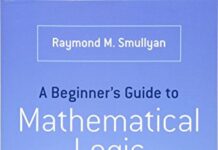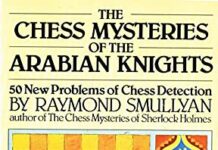
Ebook Info
- Published: 1992
- Number of pages: 270 pages
- Format: PDF
- File Size: 28.12 MB
- Authors: Raymond M. Smullyan
Description
The author of What Is the Name of This Book? presents a compilation of more than two hundred challenging new logic puzzles–ranging from simple brainteasers to complex mathematical paradoxes.
User’s Reviews
Editorial Reviews: From Publishers Weekly In Smullyan’s latest challenging collection of logic puzzles, the Sorcerer, a logician who uses logic so cleverly it seems like magic, visits an island where intelligent robots create other robots. King Zorn, Princess Annabelle, truth-telling knights and lying knaves lighten the presentation of puzzles as the Sorcerer explains the pioneering discoveries of mathematician Georg Cantor (1845-1918) who proved that there are different orders of infinity, and as he delves into paradoxes about probability, time and change. Smullyan ( The Lady or the Tiger? ) tosses in metapuzzles (which are solved on the basis of knowing that certain other puzzles can or cannot be solved) and explores self-referentiality, a property crucial to Kurt Godel’s famous incompleteness theorem. The Sorcerer closes with a tale of how Satan is outwitted by a student of Cantor’s. A mind-stretching entertainment for the serious, dedicated puzzle-solver. Copyright 1992 Reed Business Information, Inc.
Reviews from Amazon users which were colected at the time this book was published on the website:
⭐Raymond Smullyan has been described (by Martin Gardner, no less) as the most entertaining logician ever (lets leave aside the lack of competition here — after all, Kurt Godel wasn’t known to be a bundle of laughs, etc. …). One of the points of logic is to figure out what lines of reasoning make sense, and what can be considered true and false, given the proper rules of rational thought and the right information.This can be done by means of equations, symbolic expressions and linguistic tools, but this can be rather dry. A much more enjoyable means of learning to apply logical principles is through the kinds of puzzles presented by Smullyan. It is somewhat ironic — story problems are the point of greatest dread among many mathematics students, yet the logic-equivalent of story problems are the most fun!Smullyan has written several books on logic puzzles, and often starts with the device of puzzles with figuring out who is telling the truth and who is lying — here it starts on the island of Knights and Knaves, where Knights always tell the truth, and Knaves always tell lies. However, apart from this distinction, it is impossible to tell them apart. Smullyan presents the problems, and then presents the solutions, not in the back of the book or in a footnote, but as part of the narrative. It is a very natural and logical progression.In this logic-puzzle-story, Smullyan introduces the Sorcerer, not really a magician, but someone so skilled in logical thought that he is considered a magical figure. He leads the path across the novel, including what Smullyan describes as a ‘guided tour of infinity’ — it is here that Cantor (from the title, the mathematician George Cantor) is brought up. If you think all infinities are equal, guess again. If you think all mathematical infinities add up to the same, or have the same properties, you’d be wrong. But how can this be proved?Smullyan ends the book with a story of one of Cantor’s students outsmarting Satan, relying on language and set theory to confuse the naming of a set in a clever bargain.The book is a wonderful romp through logic, set theory, and rational thinking. It is not a simple book — there are a number of places where equations and symbol logic methods are used; having at least a basic knowledge of algebra and elementary logic will make this book much more fun and accessible. However, many of the puzzles rely on common sense kinds of logic.It is quite fun. Don’t be a knave; read this book.
⭐Professor Smullyan’s book Satan, Cantor, and Infinity, is an excellent mathematical novel, extremely readable for everybody from elementary schoolboys(girls) to first class college (university) students. The story concerns three major personalities – The Sorcerer living in the Knight-Knave Island and Princess Annabelle with her suitor. As in many books of professor Smullyan the first half of the story is devoted to various puzzles about knights (truth-tellers) and knaves (liars). The third chapter takes place on the island of robots. The puzzles of self-constructive and self-destructive robots throw light on problem of languages, which allow self-reference, and the famous Gödel’s theorems. This chapter may be harder to catch and the reader is recommended to consult another professor Smullyan’s book, Forever Undecided. In the rest of the book are introduced Zeno’s paradoxes concerning the problem of continuity and change (with these paradoxes are discussed the most elementary ideas of infinitesimal calculus), envelope paradox (a kind of paradox of rationality), ant the set-theoretic paradoxes (Burry’s paradox, Mannoury’s paradox, Russell’s paradox and Cantor’s paradox). The basic ideas of set theory are introduced in the form of problems of a prisoner in the Hell – Satan gives the prisoner opportunity to save himself(herself) if he(she) puzzles out an integer which Satan wrote on the paper closed in an envelope. Story also introduces the famous Continuum problem – the set theoretic problem formulated by the founder of set theory Georg Cantor in the 19th century and unsolved to our times (or at least unsolved by the more modest set theoretic principles not using some hypotheses concerning large cardinals). The story concludes with a nice Zwicker’s hypergame paradox and a legend about a gifted student of Cantor imprisoned in Hell, who outwits the Great Satan. The entire book is written in non-technical style and really is a MATHEMATICAL NOVEL, maybe a mathematical fairy tale, not a textbook. (I would only like to know if professor Smullyan is really going to fulfill his promise given in the book that he will try to present more calculus ideas in the future.) Well, the book is very delightful reading for these days – the Good defeats the Evil even in this story, even in the realm of mathematics!
⭐
Keywords
Free Download Satan, Cantor, And Infinity and Other Mind-Boggling Puzzles in PDF format
Satan, Cantor, And Infinity and Other Mind-Boggling Puzzles PDF Free Download
Download Satan, Cantor, And Infinity and Other Mind-Boggling Puzzles 1992 PDF Free
Satan, Cantor, And Infinity and Other Mind-Boggling Puzzles 1992 PDF Free Download
Download Satan, Cantor, And Infinity and Other Mind-Boggling Puzzles PDF
Free Download Ebook Satan, Cantor, And Infinity and Other Mind-Boggling Puzzles


